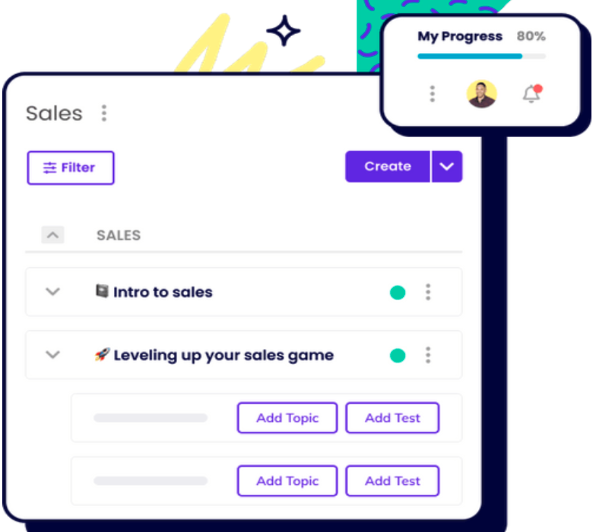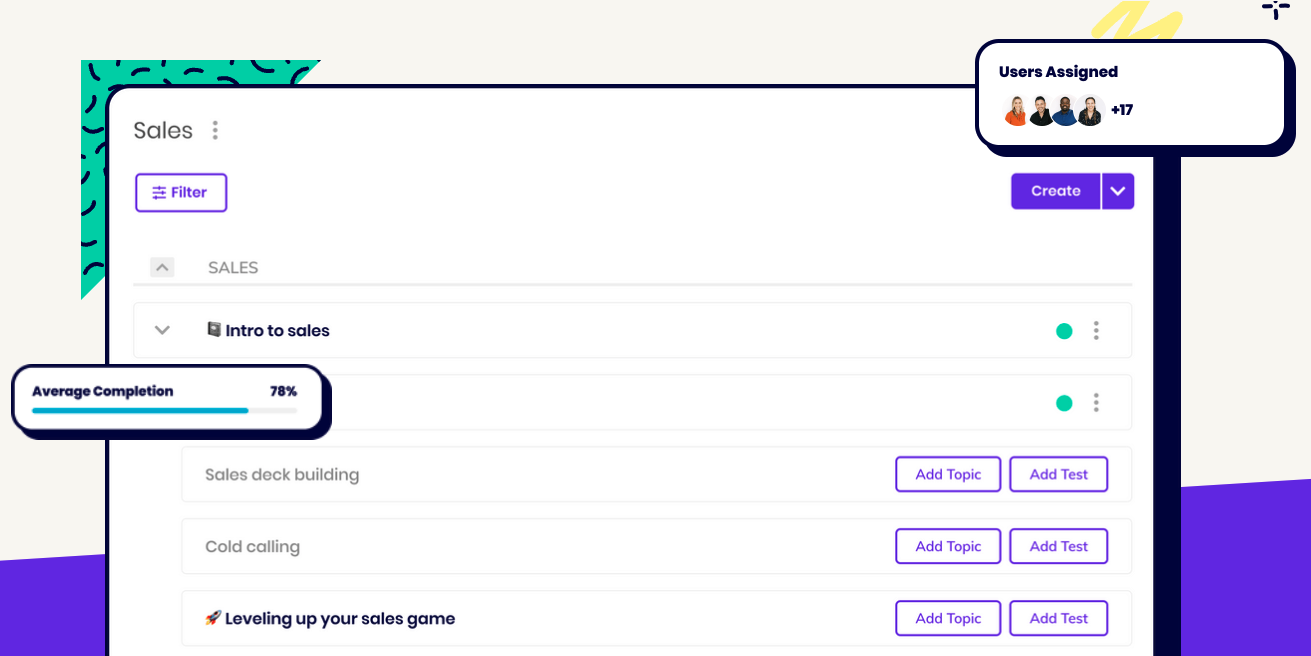
Articles
Asynchronous Learning: The Who, What, When, Where, Why (& How)
May 5, 2022

While it might seem counterintuitive, incorporating asynchronous learning opportunities into your new (or established) employee training program can foster collaboration and a stronger sense of community.
Do you have a remote team that lives across multiple states, countries, or even time zones? Or does everyone live in the same town or general area?
Trying to cobble together a training schedule that meets everyone’s date and time specifications can be time-consuming. And you’ll probably have at least one (if not many) employees who won’t be able to make the date and time you settle on.
Now, imagine offering the same level of training, but in a way that makes it easy for everyone to participate no matter where they are and what their circumstance is.
That’s where asynchronous learning comes into play. Let’s define asynchronous learning, talk about the benefits, explore the downsides, and discuss how you can easily incorporate it into your business.
What is asynchronous learning?
If you’ve ever completed an online training module for work or school on your own schedule, then you’re already familiar with asynchronous learning.
Asynchronous learning (async learning) is a form of on-demand learning in which people access their training modules, classes, or exercises when and wherever they want.
What’s the difference between synchronous and asynchronous learning?
Synchronous — or, instructor-led — learning can refer to a few things:
- Traditional training in which both trainer and trainees are in the same space at the same time.
- An online copy of a course or training session that is ordinarily taught in person.
In other words, what differentiates asynchronous from synchronous learning is not that it occurs online — both methods can be facilitated this way.
At its core, synchronous training takes a one-to-many approach to learning. It requires your employees to meet at a specific time to receive training — whether in person or via Zoom, for example — from a trainer.
What are the benefits of async learning?
There are plenty of upsides to async learning opportunities, no matter the context. We’ll start with one of the strongest benefits — convenience.
Even before COVID-19 lockdowns, we could hear the collective battle cry of employees across most (if not all) sectors. Work-life balance is essential. The power to complete our requisite responsibilities on our terms is paramount to employee wellbeing and morale. That’s where async learning supplies a vital demand.
Are some ways of delivering async learning better than others?
Of course! Just as we don’t all share one learning style, there are also multiple ways to deliver async content to fit you and your employees’ needs.
Here are just a few of them:
- Discussion forums.
- A peer-to-peer feedback loop.
- Online courses.
- Learning management systems, company wikis, or a hybrid of both.
- Pre-recorded webinars.
What is the best way to deliver async learning experiences to my team?
Rather than patch together a bunch of training modules, online quizzes, and the work of a professional trainer, you should aim to streamline your async delivery.
So, what does that mean? And how can you deliver the result to everyone who needs it?
The answer lies in taking a broad view of your goals and considering why you need async learning options in the first place.
If, for example, you have a growing company of 200+ employees who are all at different stages of their professional development — and your field is always changing — then you need to get everyone up to speed with the latest best practices and protocols, sooner rather than later.
And that’s just one of the many scenarios where delivering async learning opportunities via a learning management system (LMS) could benefit your team.
What is a Learning Management System (LMS)?
A learning management system (LMS) is a computer software program that automates your employees’ training. It’s a single platform that allows you to build, execute, and deliver async (or even synchronous) learning modalities to your team.

I’m the opposite of tech-savvy. Will using an LMS be difficult?
The short answer is no — not if you invest in an LMS-alternative. Instead, think of an LMS as an uber-modern meeting place that allows you to deliver training modules, track progress, and ensure accountability while bringing all of your employees up to speed.
And if we operate under the assumption that time is money (which it can be), then an LMS-alternative can improve your team’s performance and help you scale even faster.
How will my company benefit from an LMS?
From an improvement in engagement and morale to increased efficiency and performance, an LMS can check a wide array of boxes when it comes to benefits for your company.
Better efficiency and performance.
With an LMS, you can deliver a consistent training experience to anyone who needs it. Let’s say you have an enterprise-sized company of 1200 employees. But you just realized that 180 of those team members need training on the latest industry safety protocols. An LMS will allow you to create the training materials and modules on the backend, and then make them available to your trainees on the front end.
The ability to train your employees the same way across the board creates a consistent training experience, which provides value through equity, increased efficiency, and fewer mistakes over time.
Of course, you’ll be able to make adjustments and add/delete material as needed. That’s the beauty of the LMS. It’s all about delivering customizable (and easily digestible) content to whoever needs it when you need them to have it.

Boosts engagement, confidence, and morale.
You know your employees the best. The LMS world is your oyster when it comes to accommodating diverse learning styles.
Maybe you’ve collected data over the years and have learned that the majority of your employees prefer hands-on training. You might be wondering how to best accommodate them remotely on an LMS.
Taking advantage of virtual reality (VR) or other AI-simulated learning modules and making them available in your LMS is one of many ways of meeting your employees' learning needs. Add to that the practical aspects that your team will be able to practice what the training is teaching them will likely make them a lot more engaged and, in the end, more comfortable learning a new skill set.
With practice comes confidence, and with confidence comes improved morale. When your employees feel they can carry out their responsibilities effectively and perform them to the best of their abilities, that will have a positive impact on your company culture.
Can I use an LMS during the onboarding process?
Absolutely! An LMS (or LMS-alternative) is customizable and has the capabilities you need to train your new hires. If you want to get your new employees up to speed as quickly as possible, then an LMS is the way to go.
First impressions are important — especially when your hire starts orientation and onboarding. After all, a successful onboarding process will set your employees up to be more productive, less stressed, and more content — as well as ensuring you can retain your top talent over time.

How will an LMS specifically benefit my new hires?
Equipping your new hires with the information they need to succeed is an excellent way to put them at ease as they integrate into their new roles.
Here are just a few ways an LMS can benefit your new hires:
- Provides them with access to every company policy, SOP, and piece of colleague contact info — all in one place.
- Equips them with the tools they need to succeed.
- Reduces stress by eliminating the need for them to “search” or ask for the information they need to do their job.
- Offers easy access for remote employees.
- Creates an inclusive learning environment that can build engagement, confidence, and community.
What about continuing education and professional development?
Using an LMS for continuing education and professional development is a sure-fire way to level up your team. Nurturing your employees’ professional and personal growth is essential, but so is ensuring this process doesn’t become time-consuming or counterproductive for anyone involved. Not sure where to begin with the process? We’ve got your back.

An LMS can help you customize your employees' professional development goals to meet their individual needs while giving you the ability to monitor and track their performance.
This can provide key insights into where they might be excelling or stumbling, and give you the data points you need to lend a helping hand or delegate specific responsibilities where appropriate.
Are there any downsides to using an LMS to deliver async content?
Sure. But not many.
If you assume that using an LMS to deliver async content will be a hands-off experience for you, well, that isn’t exactly the case.
For your employees and your company to get the most out of an LMS, you’ll need to stay on top of what’s working (and what isn’t) so you can make the appropriate changes quickly.
At the same time, you don’t need to be the one wearing every hat in your organization. An LMS is a simple solution for delivering async content and delegating training, along with a host of other tasks. The right LMS (or LMS alternative) should simplify your team’s work-life — not complicate it.
Ready to provide asynchronous learning opportunities for your team?
Flexible working and training options are more important than ever. Offering asynchronous learning options can meet your team’s growing demand to continue growing professionally on their terms.
That means creating (and cultivating) a more autonomous team. The most convenient and affordable way to provide them with this opportunity and convenience is with a user-friendly, LMS-alternative.
An LMS will allow your team to complete their training and professional development effectively, on their timetable. Which helps them take ownership of their professional development and boost their morale. And that can have a positive domino effect across your company culture.
Similar Blog Posts










